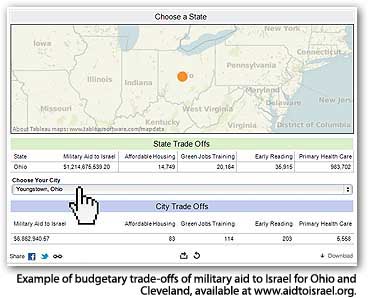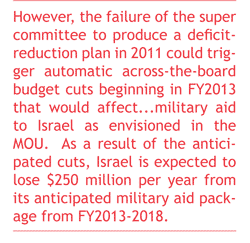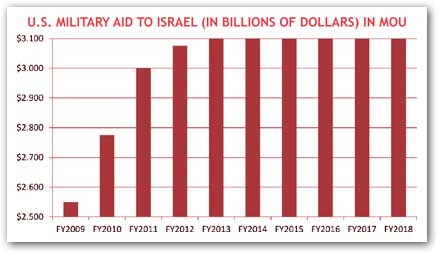Part 1: How Much Is Military Aid to Israel?
U.S. Aid to Israel (1949-2008)
 In 1949, the United States provided Israel with its first form of U.S. foreign aid: a $100 million Export-Import Bank Loan. This loan to Israel marked the beginning of an evolutionary process that resulted in Israel becoming the largest recipient of total U.S. foreign assistance in the post-World War II era. From 1949 to 2008, the United States provided Israel with more than $103.6 billion of total foreign assistance, composed primarily of military aid—$56.0 billion—and economic aid—$30.9 billion.
[1]
Statistics derived from Jeremy
Sharp, Specialist in Middle Eastern Affairs, "U.S. Foreign Aid to Israel,"
Congressional Research Service, September 16, 2010, Table A-1. Recent U.S. Aid
to Israel, p. 24, available at: http://www.fas.org/sgp/crs/mideast/RL33222.pdf (Click red citation number to open this link.)
In 1949, the United States provided Israel with its first form of U.S. foreign aid: a $100 million Export-Import Bank Loan. This loan to Israel marked the beginning of an evolutionary process that resulted in Israel becoming the largest recipient of total U.S. foreign assistance in the post-World War II era. From 1949 to 2008, the United States provided Israel with more than $103.6 billion of total foreign assistance, composed primarily of military aid—$56.0 billion—and economic aid—$30.9 billion.
[1]
Statistics derived from Jeremy
Sharp, Specialist in Middle Eastern Affairs, "U.S. Foreign Aid to Israel,"
Congressional Research Service, September 16, 2010, Table A-1. Recent U.S. Aid
to Israel, p. 24, available at: http://www.fas.org/sgp/crs/mideast/RL33222.pdf (Click red citation number to open this link.)
When the United States began providing Israel with foreign assistance, nothing about the relationship preordained Israel to become the largest cumulative recipient of U.S. taxpayer-funded weapons. In fact, the opposite is true. In 1948, President Harry Truman placed an arms embargo on Israel and its Arab neighbors and in 1950, the United States joined Great Britain and France in the Tripartite Declaration opposing an Israeli-Arab arms race. As a result, from 1949 to 1965, more than 95 percent of U.S. foreign aid to Israel consisted of economic development assistance and food aid.
Not until 1959, under the Eisenhower Administration, did the United States begin a small-scale $400,000 military loan program to Israel. It was only during the Johnson and Kennedy Administrations that this military loan program started to fund the purchase of advanced U.S. weaponry. Military grants, or Foreign Military Financing (FMF), which epitomize today’s U.S.-Israel bilateral assistance program, only began during the Nixon Administration, within the context of a burgeoning Cold War collaboration, when Congress appropriated $1.5 billion of U.S. weapons to Israel in 1974 to replenish weapons Israel used in the 1973 Arab-Israeli war. All military loans to Israel were ended in 1985 under the Reagan Administration, and replaced exclusively with military grants during a period of economic crisis in Israel. [2] This history of U.S. aid to Israel is adapted from Sharp, ibid, pp. 21-23.
 A mixture of military and economic aid grants characterized U.S. foreign assistance to Israel until 2008. In July 1996, Israeli Prime Minister Benjamin Netanyahu addressed Congress and initiated a process to phase out U.S. economic aid to Israel while simultaneously increasing military aid during a 10-year Memorandum of Understanding covering FY1999-2008. Arguing that Israel no longer needed economic aid, Netanyahu praised the United States for giving Israel, "apart from political and military support, munificent and magnificent assistance in the economic sphere. With America’s help, Israel has grown to be a powerful, modern state. I believe that we can now say that Israel has reached childhood’s end, that it has matured enough to begin approaching a state of self-reliance."
[3]
"Speech by Prime Minister Benjamin
Netanyahu to a Joint Session of the United States Congress," Washington, D.C.,
July 10, 1996, Israel Ministry of Foreign Affairs, available at: http://www.mfa.gov.il/MFA/MFAArchive/1990_1999/1996/7/PM%20Netanyahu-%20Speech%20to%20US%20Congress-%20July%2010-%201996 (Click red citation number to open this link.)
Despite some Clinton Administration and Capitol Hill officials "questioning why the United States should increase its military assistance to Israel at a time when the Israeli Government is supposed to be committed to peace negotiations with its neighbors,"
[4]
Philip Shenon, "Israel Sketches Out
an Overall Drop in U.S. Aid Over 10 Years," New York Times, January 29,
1998, available at: http://www.nytimes.com/1998/01/29/world/israel-sketches-out-an-overall-drop-in-us-aid-over-10-years.html (Click red citation number to open this link.)
and therefore subsequently in less need of arms for warfare, the proposal was implemented nevertheless. Whereas at the beginning of this 10-year period, the United States provided Israel with $1.8 billion in military grants and $1.2 billion in economic aid, by the end of the period military grants had increased to $2.38 billion while economic aid was eliminated.
A mixture of military and economic aid grants characterized U.S. foreign assistance to Israel until 2008. In July 1996, Israeli Prime Minister Benjamin Netanyahu addressed Congress and initiated a process to phase out U.S. economic aid to Israel while simultaneously increasing military aid during a 10-year Memorandum of Understanding covering FY1999-2008. Arguing that Israel no longer needed economic aid, Netanyahu praised the United States for giving Israel, "apart from political and military support, munificent and magnificent assistance in the economic sphere. With America’s help, Israel has grown to be a powerful, modern state. I believe that we can now say that Israel has reached childhood’s end, that it has matured enough to begin approaching a state of self-reliance."
[3]
"Speech by Prime Minister Benjamin
Netanyahu to a Joint Session of the United States Congress," Washington, D.C.,
July 10, 1996, Israel Ministry of Foreign Affairs, available at: http://www.mfa.gov.il/MFA/MFAArchive/1990_1999/1996/7/PM%20Netanyahu-%20Speech%20to%20US%20Congress-%20July%2010-%201996 (Click red citation number to open this link.)
Despite some Clinton Administration and Capitol Hill officials "questioning why the United States should increase its military assistance to Israel at a time when the Israeli Government is supposed to be committed to peace negotiations with its neighbors,"
[4]
Philip Shenon, "Israel Sketches Out
an Overall Drop in U.S. Aid Over 10 Years," New York Times, January 29,
1998, available at: http://www.nytimes.com/1998/01/29/world/israel-sketches-out-an-overall-drop-in-us-aid-over-10-years.html (Click red citation number to open this link.)
and therefore subsequently in less need of arms for warfare, the proposal was implemented nevertheless. Whereas at the beginning of this 10-year period, the United States provided Israel with $1.8 billion in military grants and $1.2 billion in economic aid, by the end of the period military grants had increased to $2.38 billion while economic aid was eliminated.
Military Aid to Israel (2009-2018)
 In August 2007, the United States and Israel signed a 10-year Memorandum of Understanding (MOU) to set the parameters for U.S. military aid to Israel from FY2009-2018. The Bush Administration’s MOU outlined a total of $30 billion of U.S. military aid to Israel during this period, an approximate 25 percent annual average increase over the previous level. The MOU called for incremental increases from the previous baseline of U.S. military aid to Israel of $150 million in FY2009, $225 million in FY2010 and FY2011, $75 million in FY2012, and $25 million in FY2013 to plateau at $3.1 billion annually until the expiration of the MOU. The MOU also continued to carve out an exemption for Israel that, pending Congressional approval, would allow it to spend up to 26.3 percent of its military aid on its own domestic weapons industry (all other recipients of U.S. military aid must spend all of the aid money on weapons and material from U.S. corporations).
[5]
The text of the MOU is available
at: http://endtheoccupation.org/downloads/2007israelusmou.pdf (Click red citation number to open this link.)
In August 2007, the United States and Israel signed a 10-year Memorandum of Understanding (MOU) to set the parameters for U.S. military aid to Israel from FY2009-2018. The Bush Administration’s MOU outlined a total of $30 billion of U.S. military aid to Israel during this period, an approximate 25 percent annual average increase over the previous level. The MOU called for incremental increases from the previous baseline of U.S. military aid to Israel of $150 million in FY2009, $225 million in FY2010 and FY2011, $75 million in FY2012, and $25 million in FY2013 to plateau at $3.1 billion annually until the expiration of the MOU. The MOU also continued to carve out an exemption for Israel that, pending Congressional approval, would allow it to spend up to 26.3 percent of its military aid on its own domestic weapons industry (all other recipients of U.S. military aid must spend all of the aid money on weapons and material from U.S. corporations).
[5]
The text of the MOU is available
at: http://endtheoccupation.org/downloads/2007israelusmou.pdf (Click red citation number to open this link.)
 In each of their budget requests to Congress between 2009 and 2012, both Presidents Bush and Obama asked for increases in U.S. military aid to Israel as stipulated in the MOU. Congress obliged and earmarked $2.55 billion (FY2009), $2.775 billion (FY2010), $3 billion (FY2011), and $3.075 billion (FY2012) in military aid to Israel. President Obama’s FY2013 budget request includes $3.1 billion in military aid to Israel. However, the failure of the supercommittee to produce a deficit-reduction plan in 2011 could trigger automatic across-the-board budget cuts beginning in FY2013 that would affect the ability of the United States to continue increased appropriations of military aid to Israel as envisioned in the MOU. As a result of the potential cuts, Israel is expected to lose $250 million per year from its anticipated military aid package from FY2013-2018.
[6]
Nathan Guttman, "Israel Faces $250
Million Slash in Aid," Jewish Daily Forward, December 2, 2011, available
at: http://forward.com/articles/147213/?p=1 (Click red citation number to open this link.)
In each of their budget requests to Congress between 2009 and 2012, both Presidents Bush and Obama asked for increases in U.S. military aid to Israel as stipulated in the MOU. Congress obliged and earmarked $2.55 billion (FY2009), $2.775 billion (FY2010), $3 billion (FY2011), and $3.075 billion (FY2012) in military aid to Israel. President Obama’s FY2013 budget request includes $3.1 billion in military aid to Israel. However, the failure of the supercommittee to produce a deficit-reduction plan in 2011 could trigger automatic across-the-board budget cuts beginning in FY2013 that would affect the ability of the United States to continue increased appropriations of military aid to Israel as envisioned in the MOU. As a result of the potential cuts, Israel is expected to lose $250 million per year from its anticipated military aid package from FY2013-2018.
[6]
Nathan Guttman, "Israel Faces $250
Million Slash in Aid," Jewish Daily Forward, December 2, 2011, available
at: http://forward.com/articles/147213/?p=1 (Click red citation number to open this link.)
[1] Statistics derived from Jeremy Sharp, Specialist in Middle Eastern Affairs, "U.S. Foreign Aid to Israel," Congressional Research Service, September 16, 2010, Table A-1. Recent U.S. Aid to Israel, p. 24, available at: http://www.fas.org/sgp/crs/mideast/RL33222.pdf
[2] This history of U.S. aid to Israel is adapted from Sharp, ibid, pp. 21-23.
[3] "Speech by Prime Minister Benjamin Netanyahu to a Joint Session of the United States Congress," Washington, D.C., July 10, 1996, Israel Ministry of Foreign Affairs, available at: http://www.mfa.gov.il/MFA/MFAArchive/1990_1999/1996/7/PM%20Netanyahu-%20Speech%20to%20US%20Congress-%20July%2010-%201996
[4] Philip Shenon, "Israel Sketches Out an Overall Drop in U.S. Aid Over 10 Years," New York Times, January 29, 1998, available at: http://www.nytimes.com/1998/01/29/world/israel-sketches-out-an-overall-drop-in-us-aid-over-10-years.html
[5] The text of the MOU is available at: http://endtheoccupation.org/downloads/2007israelusmou.pdf
[6] Nathan Guttman, "Israel Faces $250
Million Slash in Aid," Jewish Daily Forward, December 2, 2011, available
at: http://forward.com/articles/147213/?p=1

